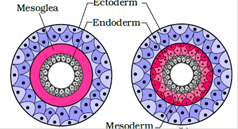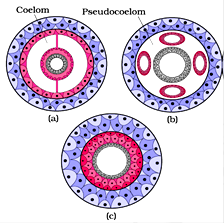CHAPTER-04 Animal Kingdom class 11 Notes Biology
CBSE QUICK REVISION NOTES
CBSE Class-11 Biology
CHAPTER-04
Animal Kingdom class 11 Notes Biology
- Millions of species of animals have been described and it becomes more necessary to classify them to assign a systematic position.
- Animals are classified on the basis of arrangement of cells, body symmetry, nature of coelom, pattern of digestive, circulatory and reproductive system.

- Incomplete digestive system has one opening but complete digestive system has two opening- mouth and anus.
- Open circulatory system- blood is pumped out of heart and cells and tissue are directly bathed in it.
- Closed circulatory system- blood is circulated through arteries, veins and capillaries.

- The animals in which cells are arranged in two embryonic layer, external ectoderm and internal endoderm are called diploblastic. Eg. Porifera and Cnidaria.

- The animals in which developing embryo has a third germinal layer, mesoderm besides ectoderm and endoderm are called triploblastic. Eg. Platyhelminthes, Chordates.
- The body cavity which is lined by mesoderm is called coelom. Animals possessing coelom are called coelomate (Annelida, Chordates, Mollusca). In some animals cavity is not lined by mesoderm but scattered as pouches in between ectoderm and endoderm, are called pseudo-coelomates (Aschelminthes). The animals in which body cavity is absent are called acoelomate (Platyhelminthes).

- In some animals, body is externally and internally divided into segments with serial repetition as in earthworm, called metameric segmentation.
CLASSIFICATION OF ANIMALS
Phylum Porifera-
- Members of this phylum are commonly known as sponges. Mostly marine, asymmetrical and have cellular level of organization.
- They have water transport or canal system. Water enters through minute pores, Ostia into central cavity Spongocoel, from where it goes out through Osculum.
- Nutrition, respiration and excretion is performed by pathway of water transport system.
- Skeleton made up of spicules or spongin fibres.
- Egg and sperms are produced by same organism (hermaphrodite). Asexual reproduction by fragmentation and sexual reproduction by gametes formation.
- Fertilisation internal and development is indirect.
- Example– Sycon, Spongilla.
Phylum Cnidaria ( Coelenterate)-
- They are aquatic, mostly marine, sessile, free swimming, radially symmetrical animals.
- They exhibit tissue level of organization, diploblastic, coelomate with single opening.
- They show two types of body called polyp and medusa.
- Polyp is sessile, fixed, and cylindrical, without gonads. Example: Hydra, Adamsia. Medusa is free swimming, umbrella like having gonads like Aurelia and Jelly fish.
- Some cnidarians exhibits both forms (Obelia). Polyp produce medusa asexually and medusa produce polyp sexually.
Phylum Ctenophora-
- Commonly known as the Comb Jellies or Sea Walnuts.
- Exclusively marine, diploblastic, radially symmetrical, with tissue level of organization.
- Body bears eight ciliated comb plates which help in locomotion.
- Bioluminescence (to emit light) is present in Ctenophores.
- Are Hermaphrodite, fertilisation is external, development indirect.
- Example- Ctenoplana, Pleurobranchia.
Phylum Platyhelminthes (The Flat worms)
- Dorso-ventrally flattened body, bilaterally symmetrical, triploblastic, acoelomate with organs levels of organization.
- Hooks and sucker are present in parasitic forms. Flame cells help in osmoregulation and excretion.
- Fertilisation is internal, development is indirect. They are hermaphrodite.
- Example- Taenia, Planaria, Fasciola.
Phylum Aschelminthes (The Round Worm)
- They may be free-living, aquatic, terrestrial or parasitic in plants or animals.
- Bilaterally symmetrical, triploblastic, pseudo coelomate.
- Alimentary canal is complete with well-developed muscular pharynx.
- They are Dioecious. Females are longer than male.
- Example- Ascaris (round worm), Wucheriria(filarial worm), Ancyclostoma.
Phylum Annelida
- Aquatic or terrestrial, bilaterally symmetrical, segmented with organ system level of organization.
- Aquatic Annelids like Nereis possesses lateral appendages parapodia, for swimming. Nephridia help in osmoregulation and excretion.
- Neural system consists of paired ganglia connected by lateral nerves to a double ventral nerve cord.
- Dioecious (Nereis) or monocious (earthworm, leech)
- Example- Pheretima (earthworm), Hirunidaria (Blood sucking leech).
Phylum Arthropoda
- Largest phylum of animals which includes insects. They have organ system of organization. They are triploblastic, coelomate, bilaterally symmetrical with chitinous exoskeleton.
- Body consists of head, thorax and abdomen, jointed appendages (jointed feet). Respiratory organs are gills, book lungs or tracheal system with open circulatory system.
- Excretion through malpighian tubules, sense organs antenna or eyes. Fertilisation internal, mostly oviparous.
- Example-
Economically important – Apis (honey bee), Bombyx (silk worm).
Vectors – Anopheles, Ades, Culex (mosquito).
Living fossils – Limulus (king crab)
Phylum Mollusca
- Terrestrial or aquatic, organ level of organization, bilaterally symmetrical, triploblastic and coelomate.
- Body divided into head, muscular foot and visceral hump. Unsegmented and covered with calcareous shell.
- Feather like gills are present between hump and mantle.
- Mouth contains file like rasping organ for feeding called radula.
- Example- Pila, Octopus.
Phylum Echinodermata (The Spiny Skinned Animals)
- Endoskeleton of calcareous ossicles, marine with organ system of organization.
- Triploblastic, coelomate, presence of water vascular system help in locomotion, capture of food and respiration.
- Sexes are separate, fertilisation is external and development is indirect.
- Example- Asterias (Star fish), Cucumaria (Sea cucumber), Antedon (Sea lily).
Phylum Hemichordata
- Worm-like marine animals with organ system of organization, bilaterally symmetrical, triploblastic and coelomate animals.
- Body is cylindrical, composed of anterior proboscis, a collar and a long trunk.
- Open circulatory system, respiration by gills, excretory organ is proboscis glands.
- Sexes are separate, fertilisation external, indirect development.
- Example- Balanoglossus, Saccoglossus.
Phylum Chordates
- Presence of notochord, have dorsal hollow nerve chord and paired pharyngeal gill slits.
- Bilaterally symmetrical, triploblastic, coelomate with organs system levels of organization.
- Closed circulatory system, ventral heart, post-anal tail is present.

- In Urochordata, notochord is present only in larval tail. In Cephalochordate it extends from head to tail and persists throughout the life.
- Vertebrata possesses notochord in embryonic period which is replaced by vertebral column in the adults.
- Sub-phylum Vertebrata is further divided into two division Agnatha( lacks jaw) and Gnathostomata ( bears jaw).
- Gnathostomata is further divided into two super class- Pisces( bears fins) and Tetrapoda (bears limbs).
Class Cyclostomata (Circular mouthed fishes)–
- They are ectoparasites on some fishes. They have sucking and circular mouth without jaws.
- Body devoid of scales, gill slits for respiration, cranium and vertebral column is cartilaginous.
- Circulation is closed type. They are marine but migrate to fresh water for spawning and die after few days. Larva return to seas after metamorphosis.
- Example– Petromyzon (Lamprey), Maxine (Hag fish).
Class Chondrichthyes (The Cartilaginous Fish)
- They are marine, streamlined body, have cartilaginous endoskeleton, cold blooded, tough skin with minute placoid scales.
- Gill slits are separate without operculum.
- They have powerful jaw and are predators.
- Air bladder is absent, hence to avoid sinking swims constantly. Heart is two chambered, cold blooded (Poikilothermous).
- Sexes separate. Males have pelvic fins which bear claspers. Internal fertilisation, many are viviparous.
- Electric organ is present in Torpedo and Poison sting in Trygon
Example- Scoliodon (Dog fish), Carcharodron (great white shark).
Class Ostechthyes (The body fish)
- Marine and fresh water both have bony endoskeleton. Streamlined body with four pair of gills covered by operculum.
- Skin is covered with scales, air bladder is present, and heart is two chambered, cold blooded.
- Sexes are separate, fertilisation external, oviparous and development direct.
Example
Marine- Hippocampus (Sea horse), Exocoetus (Flying fish).
Fresh water- Labeo (Rohu), Catla ,Clarias (Magur).

| Amphibia | Reptilia | Aves | Mammals |
| Can live in aquatic as well as terrestrial habitat. | Mostly terrestrial animals. | Presence of feathers for flying. | Mostly terrestrial, a few can fly and live in water. |
| Two pairs of limbs | Limb two pair if present. | Forelimb is modified into wings. | Two pair of limbs. |
| Moist skin without scales. | Dry and cornified skin having scale or scute. | Skin is dry without glands. Long bones are hollow with air cavities. | Skin possesses hairs. Mammary gland is present to produce milk. |
| Respiration by gills, lungs or skin. | Respiration by lungs. | Respiration by lungs. | Respiration by lungs. |
| Heart three chambered, cold blooded. | Heart three chambered, Crocodile 4-chambered . | Heart is four chambered, warm blooded. | Heart four chambered. |
| Oviparous | Oviparous | Oviparous | Viviparous or Oviparous. |
| Rana (frog), Salamander, Hyla | Chamelion, Crocodilus, Naja | Columba, Pavo, Ostrich. | Platypus(oviparous) Camel, Dog, Blue whale. |
Comments
Post a Comment